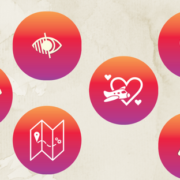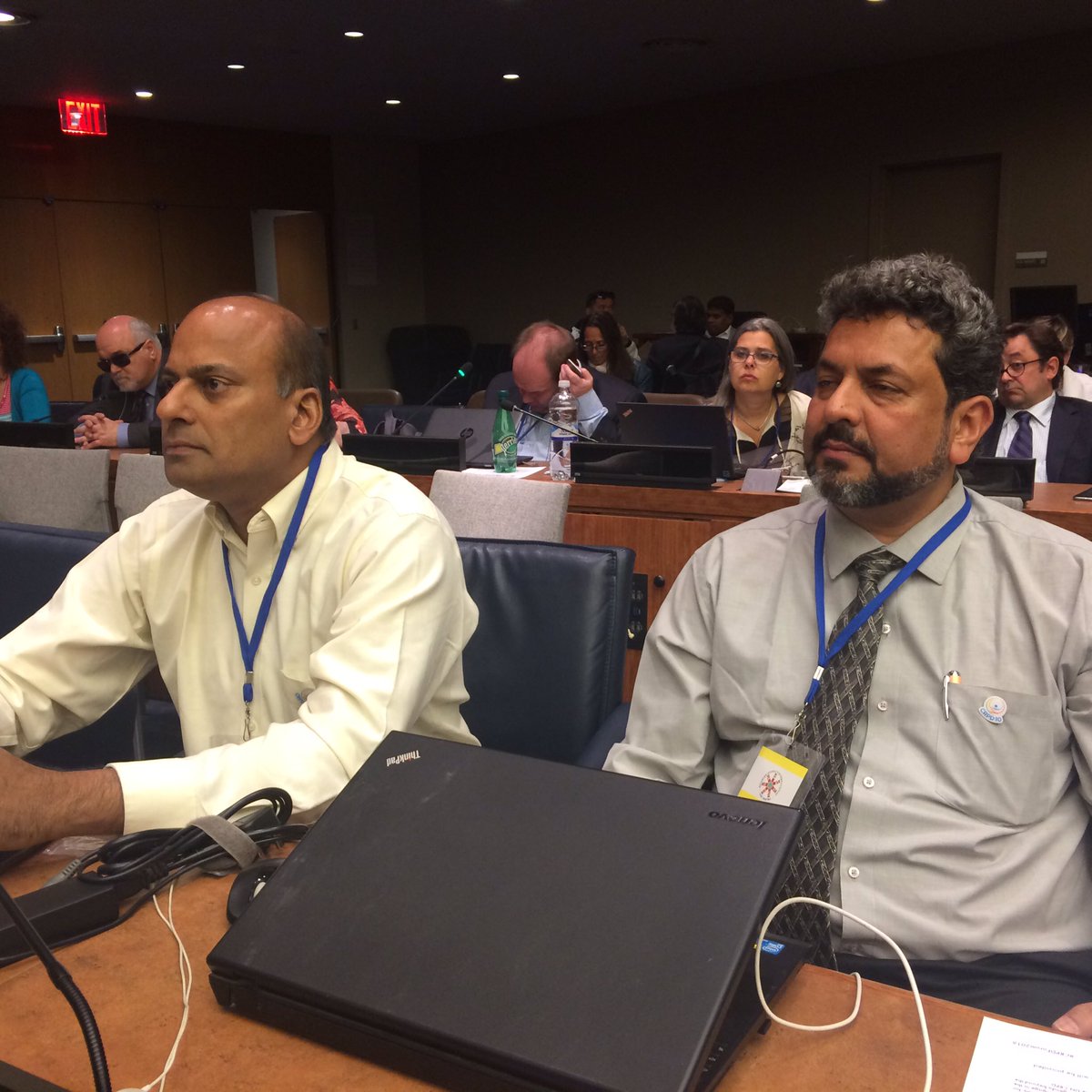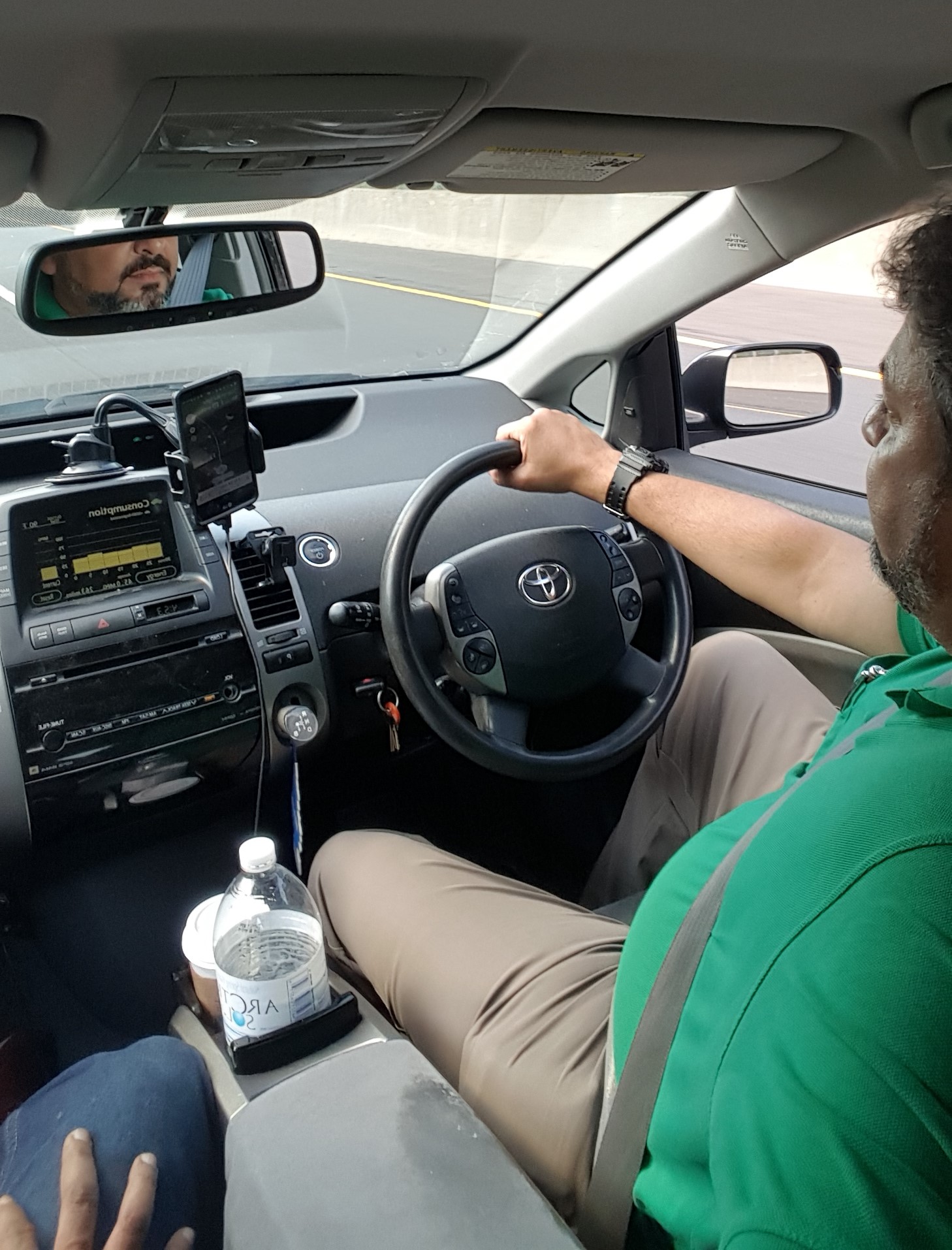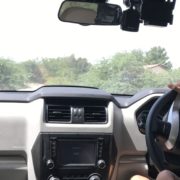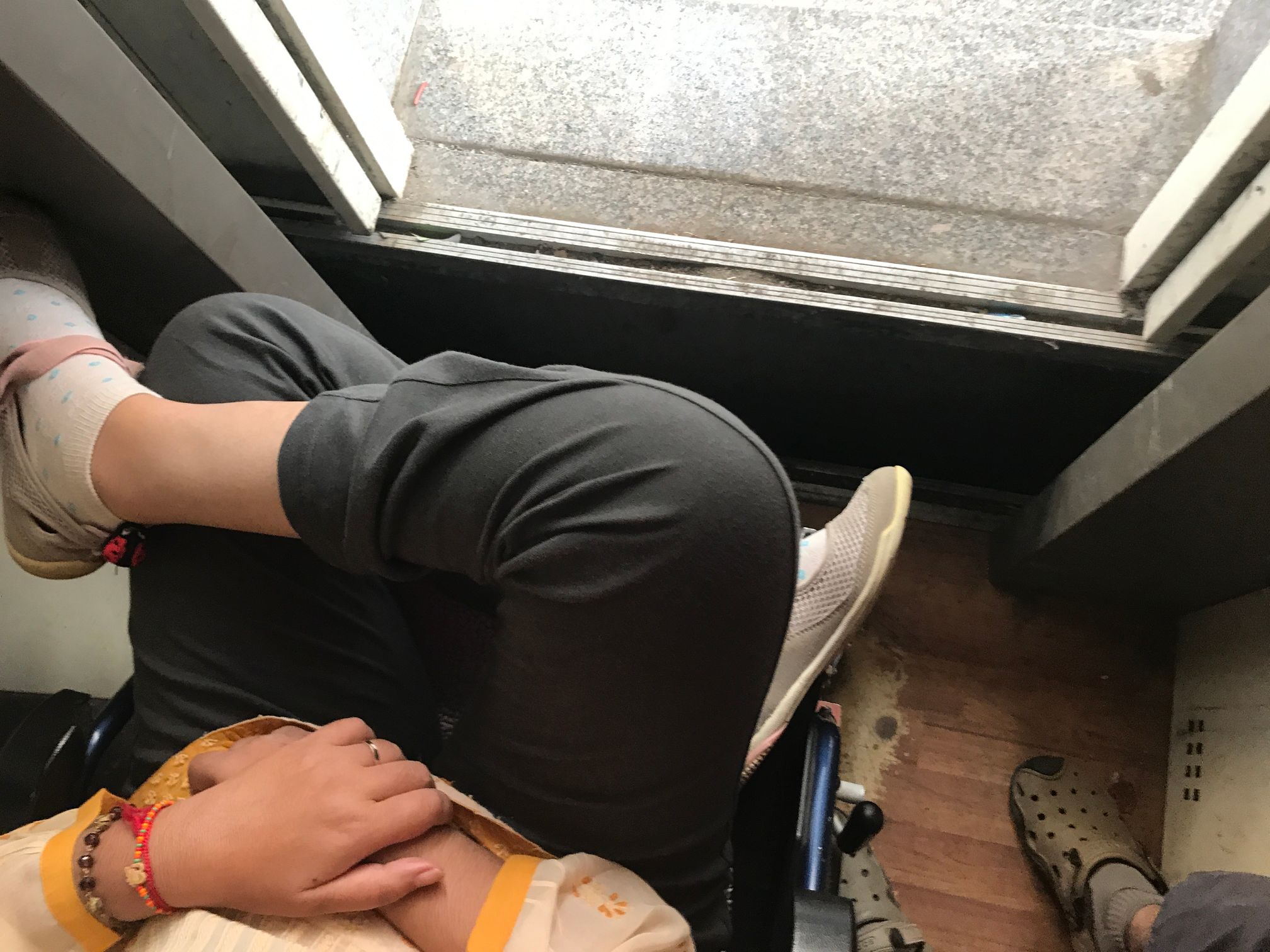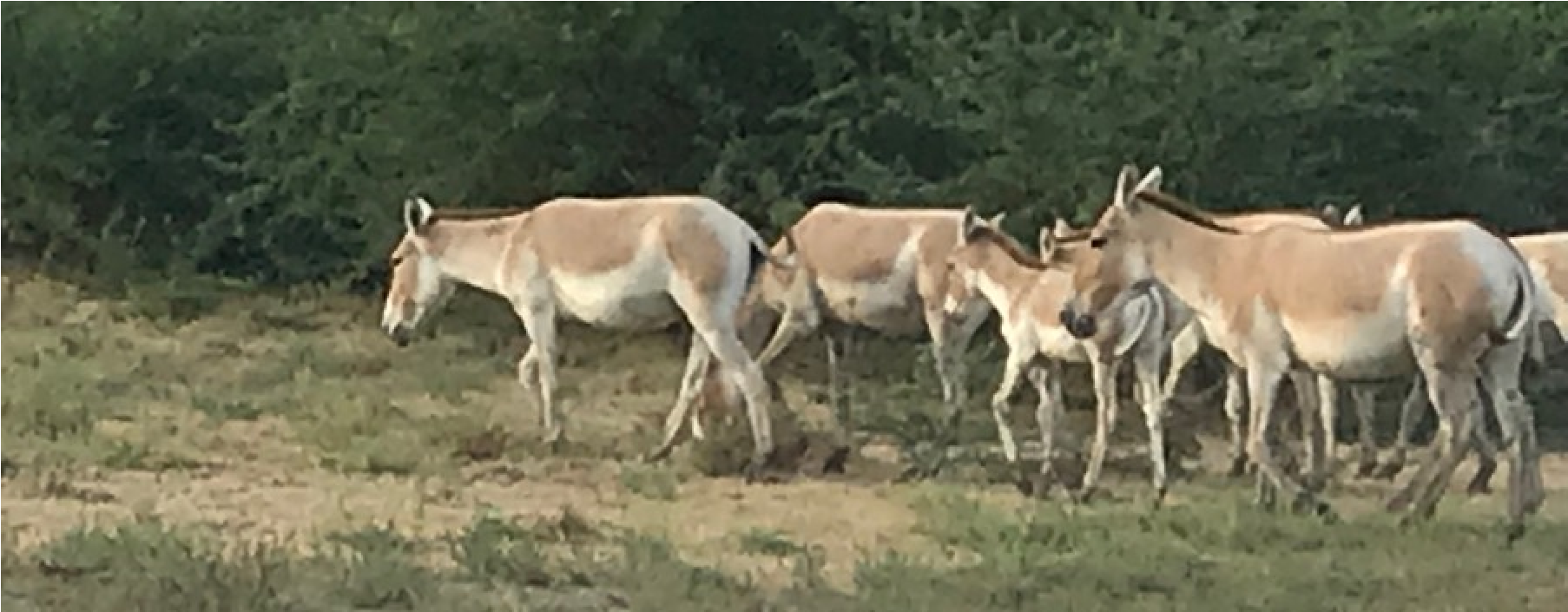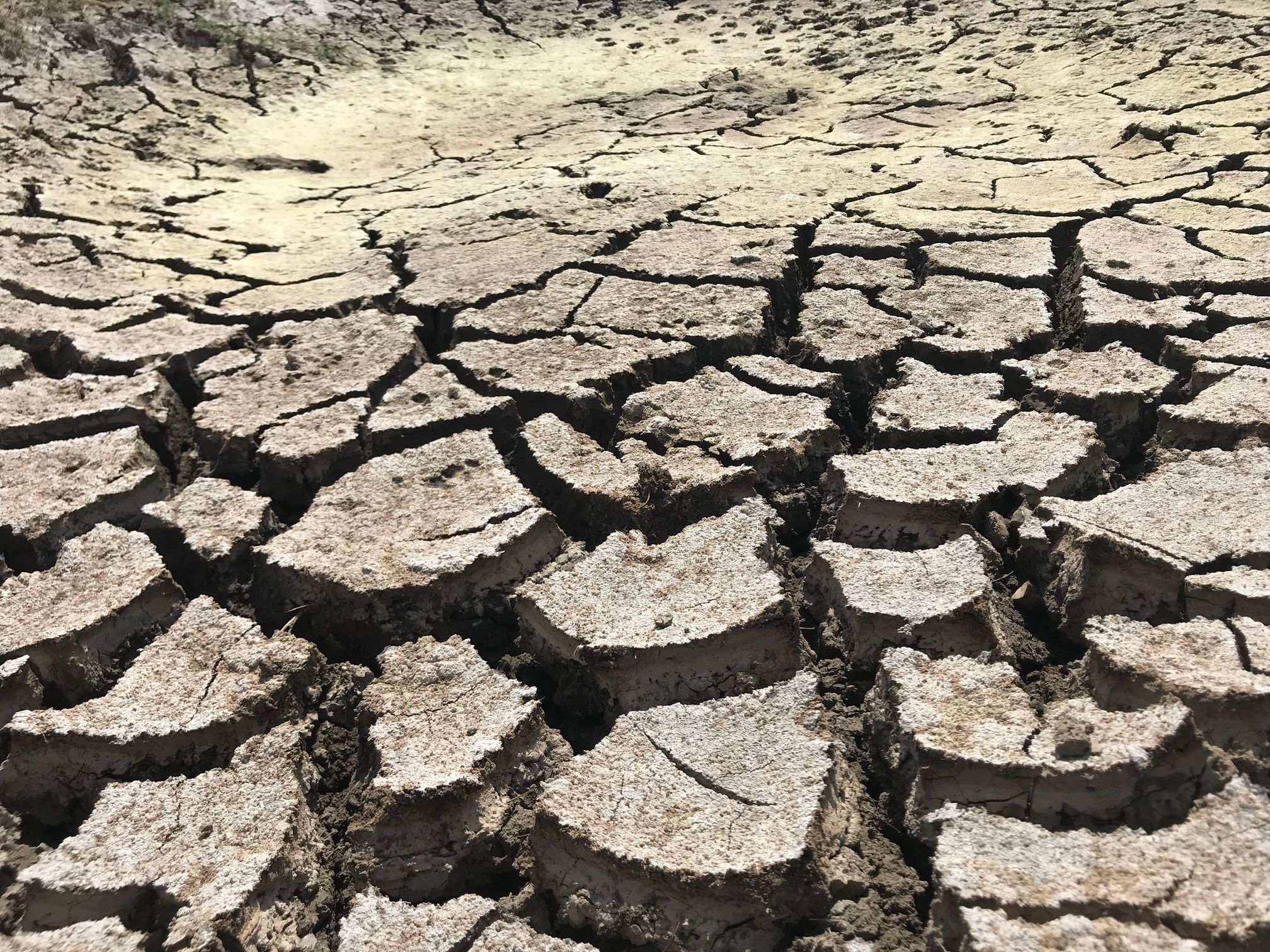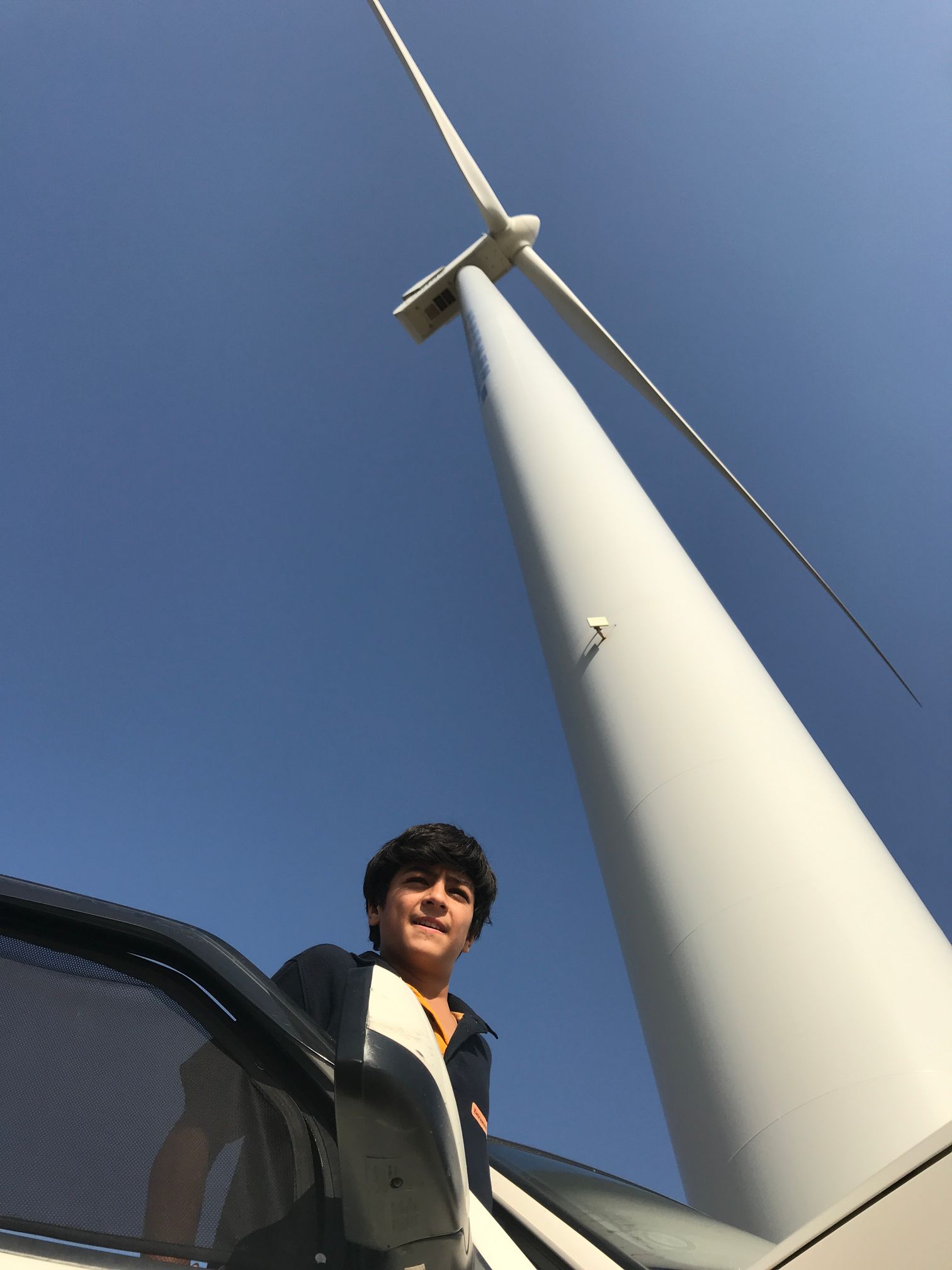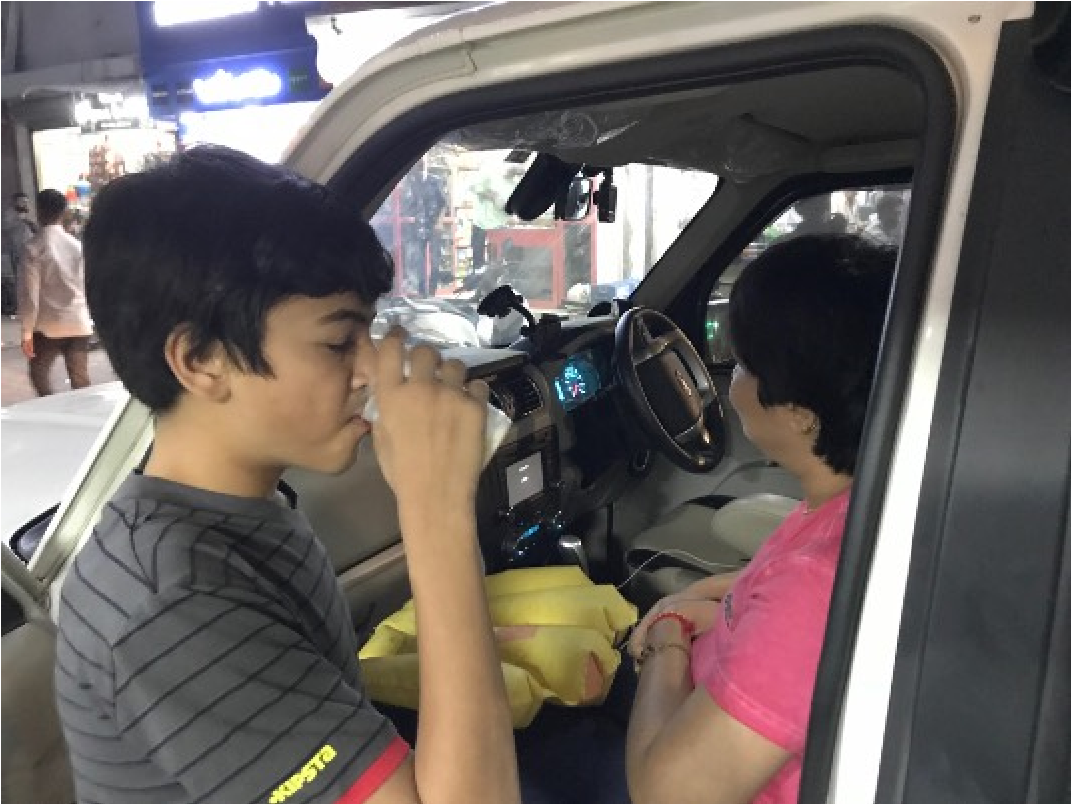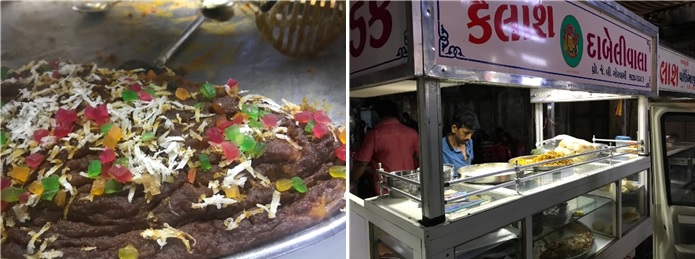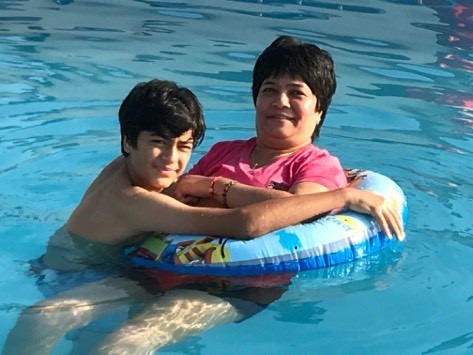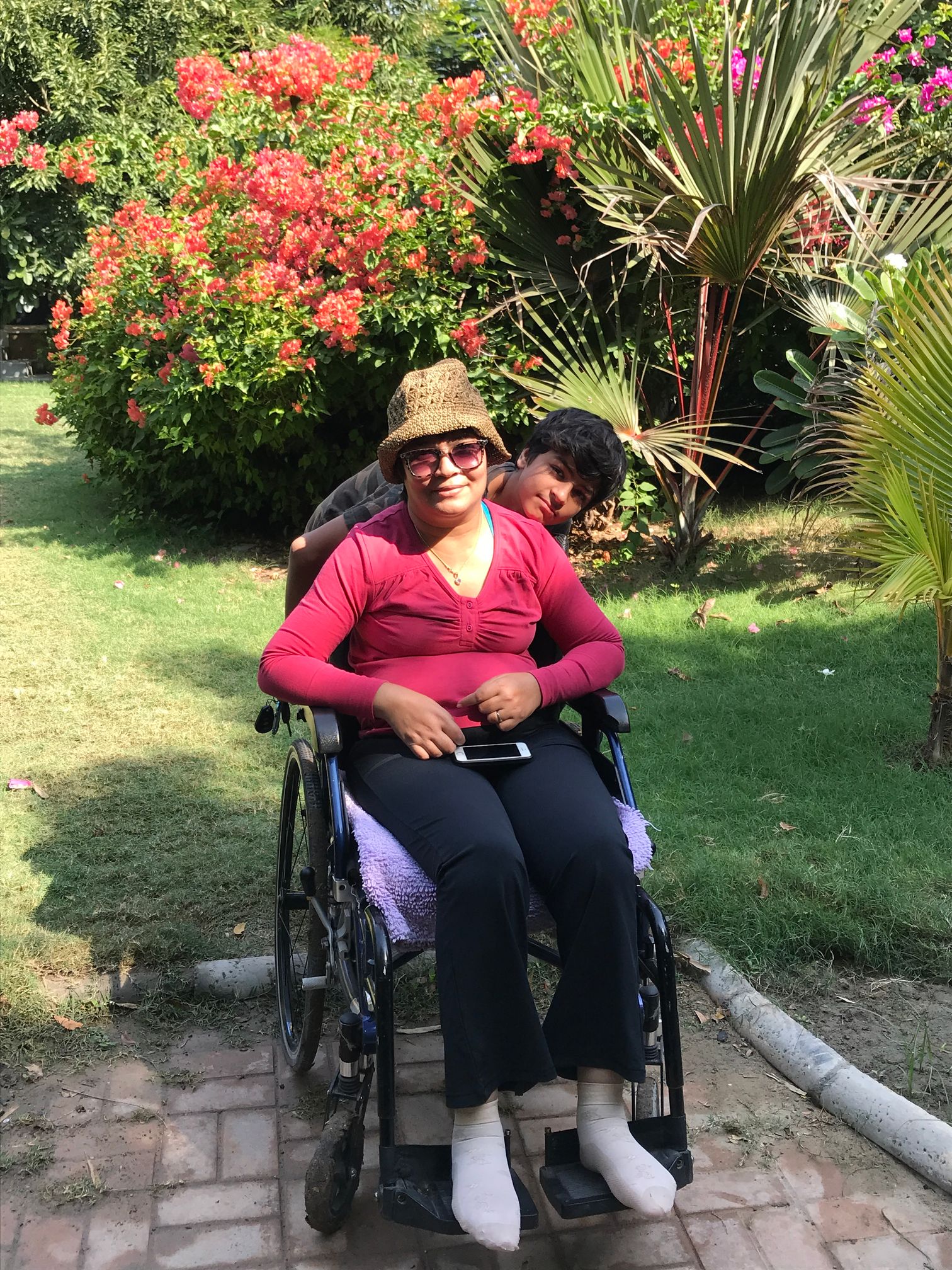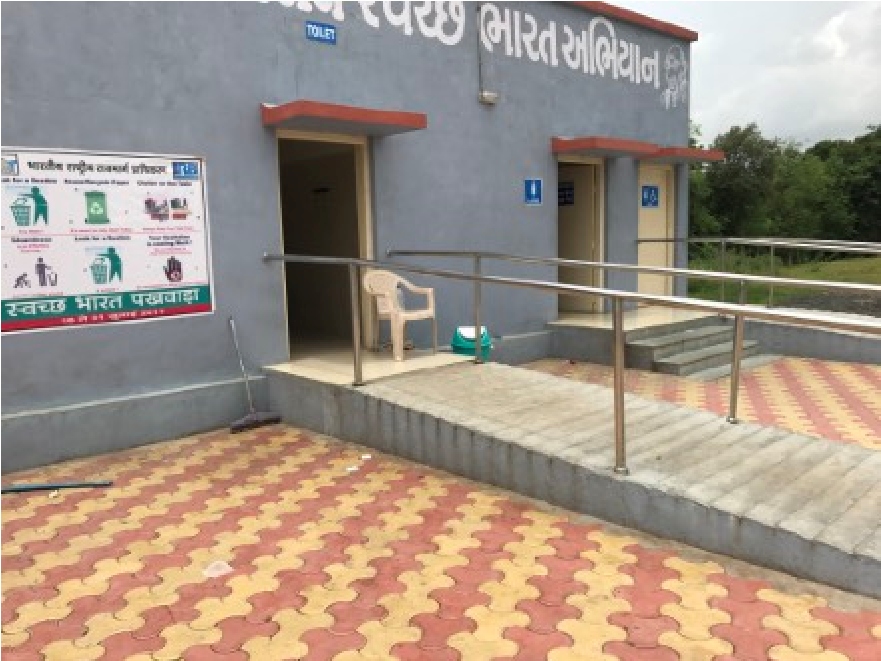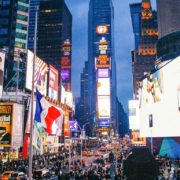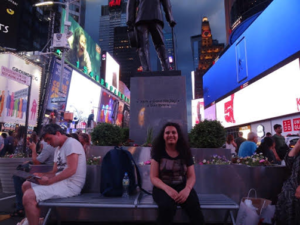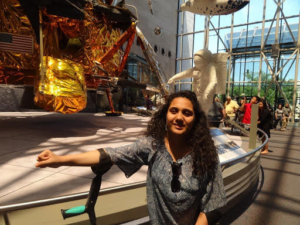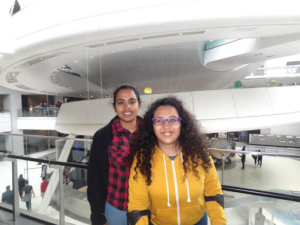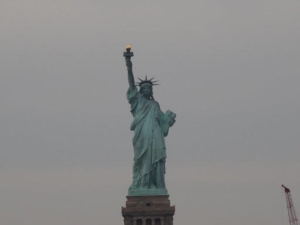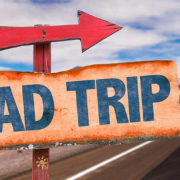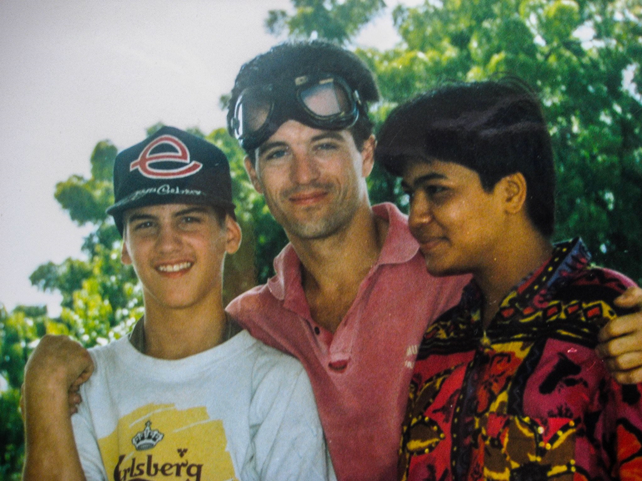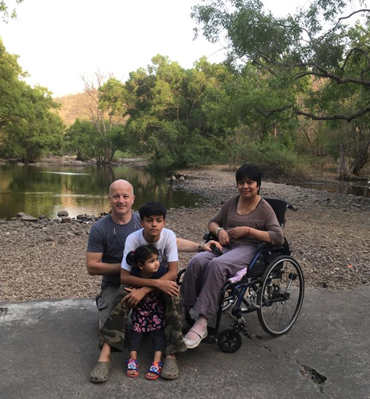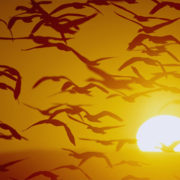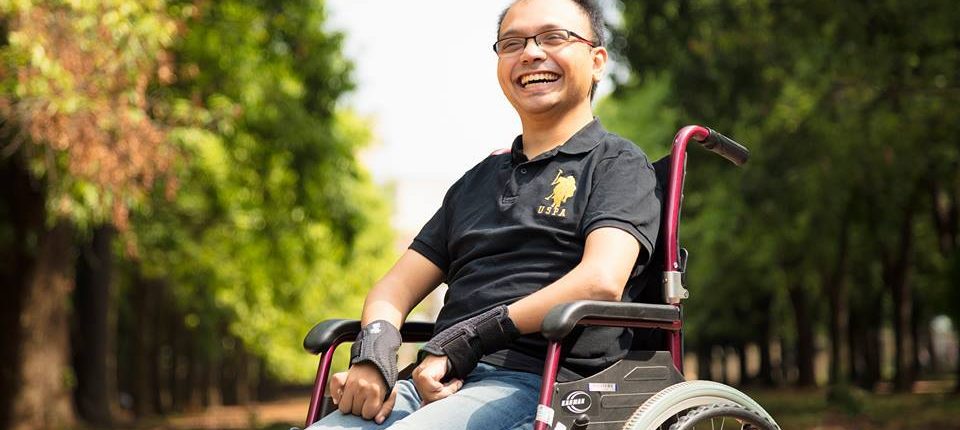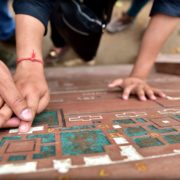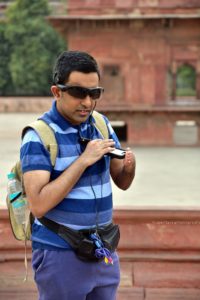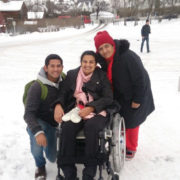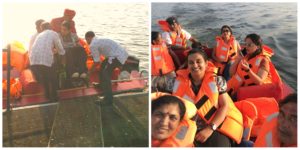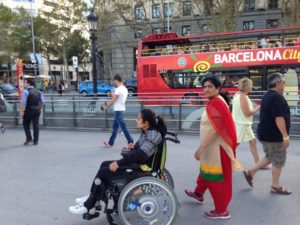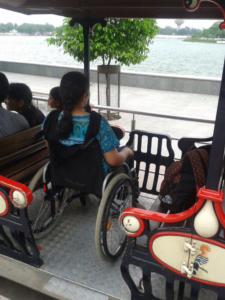Posts
Road Trip with Windmills and Arks
/0 Comments/in Personal, Travel /by Neha AroraThis post is the second in the series of travel with disability blog by Peter Gibson. He prefers to take his wife and son for road trips.
Starts and Unexpected Stops
We set off on the road from Vadodara at 4:30 and within a very short time we were in a traffic jam on NE 1 Vadodara-Ahmedabad Expressway. A bus was parked in the fast lane with a burst tyre!
Just as we were passing Ahmedabad we saw the sun setting like a huge orange ball. Slightly unreal looking like a typical tourist destination poster for sun-starved North Europeans.
We stopped early at 7pm to top-up the windscreen wiper water. The windscreen was splattered with insects and as the last of the water sputtered to nothing our windscreen became smeared. I couldn’t see clearly through the glare of un-dipped headlight beams of oncoming vehicles.
I found a water fountain of filtered and chilled water in the fuel station! Very smart. When the windscreen bottle was full I got some old newspaper and cleaned the smeared glass until it was crystal clear again. We then had a least another two hours of driving to do before we reached the area where we needed to find a hotel (near the way into the Little Rann of Kutch – a “small” desert)
First Food Stop – One Small Step
As we were pulling out of the fuel station, where we got the water, we saw Jyot Hotel which looked like a clean and simple road-side restaurant. It had only one small step up and a large door so getting in was easy. The tables were a good height and reasonably clean by roadside standards. Luckily there was no among crossbar across the leg of the table so Jagu could get her wheelchair under the table top without banging her footrests.
The food was well presented but had suicidal level of salt and oil. I made a mental note to request less oil/salt as we head further west.
After this we moved ahead to a secluded area for a quick road side toilet stop. We carry a folding toilet chair and sadly have to use the open-toilet (i.e. wherever you can find space as there is no disabled accessible toilets within 100km).
We have only ever seen one accessible toilet which was on National Expressway 1. At all other places we have to use a folding chair. We find a secluded spot and open both doors offside passenger doors and place it between them. It gives a little privacy but it is difficult and undignified for all involved.
Seeing Scary Steps but Saved by Semi-Lift
Then we moved on looking for a hotel. It was getting unlikely that we would find a place as we had our turn off to the Little Rann of Kutch coming up but fortuitously the Highway took an unexpected turn towards Rajkot and although we were now on the wrong road we soon came across a half decent looking hotel. Aptly named Cross Roads.
I viewed the horrendous 30 odd steps of the metal staircase upto the hotel entrance which was on the 1st floor from the car. It gave me a horrible shiver of expectation because the place didn’t look like it had a lift. Carrying Jagu up 30 steps even with help is a dangerous and undignified process for her and us carers. Lack of accessibility at the hotel was evident.
However, when I went to scout the place it was surprisingly clean. Basic but clean and yes it had a lift of sorts! Get this. There were no doors on the Lift and there were no doors on each floor (the manager muttered something about “Karab ho gaya” – it went bad). No Kidding!!
The Lift was too small for a wheelchair, so we put Jagu in a lotus position in her chair and dosed the foot rests. We named it – The Yoga Lift.
Basic Bedroom with Bathroom Barriers
The room was spacious enough but the usual small bathroom door with a step up. It was not at all suitable for wheelchairs or people with disabilities.
The room was clean and simple and at ₹1000 for a three-bed room it was ₹8000 cheaper than the rough and ready Jogad Eco Camp which we saw is nearby (Rs 2200 per person per night with full board and a desert tour).
Day 2 Desert – Little Rann of Kutch
We drove about 40 Km to the beginning of the desert to look for the famous the Wild Ass of Kutch. The Wild Ass is something between a donkey and a horse and is indigenous to the Little Rann of Kutch desert.
Here we found several herds of Wild Ass grazing on what looked like the most bare sand with a very few tufts of grass. It is surprising that they can survive and even thrive on such barren landscape.
We drove careful avoiding the damp patches. Parts of the desert are flooded for part of the year and this is why there is salt industry in this area. This is the perfect way for a person who cannot walk to enjoy nature without having to get into a wheelchair. We have done many safaris in our Four-Wheel Drive Mahindra Scorpio. Freedom from the hugely expensive safari tours is a great boon. I have a lot of experience driving in the desert of Qatar so I know the dangers of getting stuck and how to avoid this.
As we were off road and there was no danger of hitting anything I let my son drive. The car is automatic so it’s easy to drive. We enjoyed few hours looking at the scenery and the birds and then set off out of the desert looking for a place to have lunch before heading West to Mandvi.
Cracks, Crannies and Condiments – Textures of the desert.
Jagu is an artist and she uses a lot of abstract textures she finds in nature. The desert with its salt-pan flats covered in cracks and crevices is a perfect place to collect texture samples. Jagu tells me what she want photos of and the angles and so on. She then imports this into her artworks which she creates using her iPad.
Long and Winding Road Passes Windmills
Soon into our second day on the road we past the famous port of Navlaki. As the sun was setting we were presented with the silhouettes of towering turning wind-turbines. We went offroad again to take a closer look. It was surreal standing next to these massive machines which make no sound other than a gentle swishing sound.
The Destination is the Journey… scary incidents or
– The Importance of Using of Seat-belts
Our trips are not well planned. We don’t generally book hotels in advance as we find the important information about accessibility is usually lacking. However we use google maps and Tripadvisor and LastMinuteDotCom extensively. So with these tools we headed towards Mandvi. We hadn’t planned to stop there but it looked good in TA. Zack was checking out places as I drove the last 50Km in the dark.
Just before we entered Mandvi district we had heavy traffic on a normal single-track road. All of a sudden, a bull was running across the road narrowly being missed by the heavy traffic. I had to swerve violently to avoid it and it’s horn came into contact with my mirror. I always keep an eye on motorbikes in my mirrors and so I managed to avoid hitting one on our passenger side.
Jagu cannot support her upper body and can easily fall over so the seat-belt is a great support and in incidents like this it can save a disabled person from striking their heads against the door or window. Everyone has to wear seatbelt in my car whether we are in city doing 20 kph or on the highway doing 120 kph.
Shaken we drive on into Mandvi and look at a few hotels. Some are charging exorbitant amounts for very second-rate facilities but we found a budget hotel with ground floor rooms.
Day 3 – Maiden Voyage to Mandvi
It’s our first time in this famous ancient shipbuilding port. It was much better than we expected. In the morning we drove into town and stopped to look at the wooden skeletons of amazing ships being built.
Having the car is a great boon. I could position it on the roadside so she could get a good look while Zack and I explored the shipbuilding site. It is on the riverbank running though the centre of town.
Rough and Rubbish Strewn Sea-Front but Delightful Town Centre
On our first night in Mandvi we explored a bit by driving around. We found the popular touristy sea-front in the centre of town which was noisy, dirty and generally unattractive. We carried on exploring the very narrow street and came to the town centre where, in a small Chowk (square), there were several roadside laris (shiny and well-lit food carts). All of these were selling freshly prepared local specialities like Kutchi Dabeli. This is a sweet and savoury mix of peanuts and crushed vegetables stuffed in a bread roll which is heated up on a metal plate with butter. The stall opposite the Dabeli Lari sold fantastic Limbu Pani (fresh squeezed lemon juice).
We had a several snacks and then lemon juice. Again travelling by car on road is a way a disabled person can enjoy these things without too much hassle of using wheelchair chairs in potholed and narrow roads. In our car Jagu is nearly at the height of us as we stand next to the door. This way we enjoy together on the same level.
During the day we checked out the town some more, looking at the old buildings and exploring the nearby beaches. We found a beach that we liked and decide to go swimming the next morning. We decide to splurge a bit and changed our accommodation. We found a resort on the East edge of the town that had a swimming pool, individual huts and very nice restaurant and an amazing private beach front.
It had slopes to a couple of the “Tented” rooms but they were too steep and the 40mm high door threshold was a problem for the wheelchair. The rooms were not accessible. Not even the room “allocated” for disabled but they were reasonably spacious.
Dangerous Slopes
There were slopes to the restaurant and the poolside. Both were too steep and both had no hand-rails. There were no accessible toilets anywhere on the site. Despite this we enjoyed our night there and went to the beach in the evening.
Beach Sunset
We carried Jagu over the small gate to the beach as it was too narrow for the wheelchair and then took her in a plastic chair down to the beach. Zack and I swam for an hour enjoying the clean and warm water.
Day 4 – Safe Swimming – Tetraplegian Style and Heading Back East
The following morning, we took Jagu for a swim in the pool. It was very clean and not too cold.
We have devised a good technique for getting Jagu into the pool. First of all, before we go out we put on her swimming clothes while she is lying on the bed in the room. Then when we get to the pool we need three people. Zack is in the pool to guide her once she is on the pool-edge. I lift her from the back and our assistant lifts her beneath her knees and we transfer her from the chair to a wheelchair cushion we have put not the pools edge. Then I lower put on the floatation ring and lower her into the pool while Zack makes sure she doesn’t roll over. It’s a bit complicated but once she is in it is very nice for her to feel “weightless”.
We really enjoyed Mandvi but we wanted to see more of the desert so we decided to start our journey home and come via the north side of the Rann of Kutch. On the way we stopped to look at an ancient fort. We could drive all the way up inside the perimeter wall. There I found some interesting sandstone walls that had stones that were worn in a strange way that looked like 3D writing. Jagu loves this type of textures so I took some pics for her.
It was nice for Jagu to see this all fairly closely as most forts are totally inaccessible to wheelchairs.
That day we arrived late at night in a hotel north of the Rann of Kutch. It was a typical low level roadside hotel. So no lift and a lot of stairs. The management and staff were very helpful and kind. The room was clean and large so despite the difficulties we managed a good night’s rest.
Day 5 – Arriving at Rann Riders Ranch
The next day we set off late morning and arrived at a Safari lodge where they offer riding and jeep safaris. It is a beautiful place with interesting and comfortable rooms in a garden full of small ponds with lotus and fish. They even had a very small swimming pool which was nice for cooling off.
Jagu really enjoyed all the plants which she had me taking lots of pictures. We had really nice food and enjoyed meeting the many domestic animals including geese, cats, dogs and best of all …horses

The open sided restaurant of Rann Riders. Beautiful Ancient gateway to a town on the East side of the Rann of Kutch.
Day 6 – Safari and Homeward Bound
Early in the morning safari and saw more Wild Ass and birds in the desert. Also, we saw an amazing gateway from an old trading town. In the afternoon some local tribals came to sell their beadwork.
It was difficult to bath Jagu because the bathroom was so inaccessible but we managed to give her a sponge wash.
On our way home we stopped on the National Expressway 1 where there are “Accessible” Toilets. They aren’t correctly arranged or equipped but they have a good slope and adequate space. It is an attended toilet, so it is clean.
It was a really enjoyable trip for the nice surprises. The best way to travel is to let it just happen as you go along. Too much planning leads to disappointments. Flexibility is the best but for the disabled this has extra challenges. Having our own car and own equipment helps us adapt. Also, we always travel with a helper.
Things that help for paraplegic travellers: a helper to lift the person in and out of the car, for bathing, toilet help etc. A folding toilet seat. Wet wipes. An ample supply of “Sense of Humour” and a lot of patience.
We plan to go to Kutch again… we feel there is much more to enjoy there.
Peter Gibson is an avid traveller and also the founder of Enable Me Access promoting Barrier Free Access for People with disabilities in India. This post is the second one in his series of travelogues which he would be writing regularly to inspire more and more people with disabilities to travel and explore the planet.
Sweet and sour memories of my travel to United States of America
/1 Comment/in Personal, Travel /by Neha AroraA family travel to the US, hell yeah! Right? Who doesn’t want to attend their sister’s graduation if it allows for you to have a one-month trip to US including places such as NYC (Shopping in Manhattan et al, thanks to Bollywood).
Ready, I boarded my flight. Her graduation was a lot of fun and then we made our way to Washington to kick start our travel. We always get to the airport 3 hours earlier –traversing the long airport corridors and security check always takes me longer. You see I walk with crutches and have a barrage of other limitations – Cerebral palsy does that to you. For one, they always stop me at security check and thoroughly check my fancy shoe apparatus, then the crutches always get a life of their own in the security check machines and take forever to get cleared. But for every time I spend more time in security check (which I hate), I do love the special lines for me at all the counters. (One of the many things my sister has come to appreciate me for.)
So we land in DC – DC means museums and meeting the Donald! We started with the air and space Museum where I saw the 1st plane made by the wright brothers. We also visited the national history and art museum which were very cool – so much history! Next, we walked down to the white house and the Lincoln memorial. Also saw the Washington monument (or the pencil as I liked to call it) from afar. After walking this much I was nearly dead. Walking takes six times the energy for me as compared to anybody else, and leads to frequent backaches and excessive stiffness. I also take longer than most people, so my family has to always rationalize and choose what we can do or not. This means every trip requires excessive planning.
I was ready to go home, but my dad always wants to do more – so we sat by the Jefferson memorial to appreciate the beautiful sunset. What a beauty it was – the sunset and the lake. A little more walking the family always says. (generally, it’s a lie – like the time I almost cried in The Vatican because my body was hurting but my mom wanted to see a little more). Most times, by the third day of a trip I just didn’t give a damn. As much as I loved DC, the museums and the memorials, I was so exhausted that I took Day 3 off. I spent the day lying in bed. My sister and I missed Annapolis which my parents say was breathe taking. On days like this, I wish I was ‘normal’. On most others, I am glad I am well-travelled!
The next day we took a bus to travel to New York. The moment we step foot in the city, we went to the magnificent Times Square. The skyline and the number of people were mesmerizing. We sat there for a while and clicked some selfies (please do not diagnose me with a disorder, it is not that often, promise).
The next day we went to the museum of Modern Art. The exhibit on Asia was very well done, I think I learnt more about Indian history that day than I have ever read in my books. I was glad to see an exhibit on Africa also.
We also walked, sat and talked and again walked around the central park. The lake there was beautiful. I was glad to see the infrastructure and facilities for individuals with disabilities even in a park. The lake was accessible through a ramp. The next day we went for the cats Broadway show. I was pleased to see the facilities available there also. Something that I will never forget was the fact that one of the ‘cats’ came down to take a picture with me during the interval while everyone crowded the stage. It was amazing. We also went shopping! People generally like shopping, retail therapy it is called. For me however, it becomes more of a problem. Additionally, a lot of clothes do not fit me because of the braces that I wear. But don’t worry. I found a solution to that, well kind of, my sister tries clothes for me and we buy them accordingly. Trust me it saves a lot of energy and time.
By the fourth day I was so tired and had pain in my back to such an extent that we had to rent a wheelchair, this was a first timer! Or the throne as I like to call it. After all, how many people get to travel in New York without walking. We went for a sea cruise as well. The view of the statue of liberty and the Brooklyn Bridge was amazing.
Here is a glimpse ????
The view from the 88th floor of the Empire State Building cannot be missed. We also went to the Niagara Falls. The maid of the mist ride was awesome! One moment you were dry and the other there was water all over you. We also saw the Statue of Liberty.
The cheesecake at the Trump Tower was mouth -watering. And let’s just stop the discussion about the Donald at that. Interestingly, the moment I started to get comfortable with the idea of using a wheel chair on my travel something funny happened, I was feeling extremely cold, possibly freezing. But as I walked into a restaurant for dinner, I wasn’t feeling that cold any longer. This small incident made me realise that I couldn’t use a wheelchair in the long run. We never give up on walking, do we? I guess I never really learnt to take the easy way out. Amazing views and a bag full of memories. What a trip it was.
Shivangi is a Psychology graduate, currently pursuing post graduation and former Coordinator at REACH, LSR. She loves travelling with her family.
In the Beginning – Early Adaptions to Disability
/0 Comments/in Personal /by Neha AroraJagu and I were married in ’92 after a very short and socially controversial courtship. We were classmates; typical college love affair except she was a Brahmin and I, British, white and obviously non-Hindu.
Our first dates alone together were on my Enfield Bullet. We would go to the Mahi River where I taught her how to swim. At that time, there were regular riots in Baroda and so after the Fine Art Film Club viewings I took her home on the bike… stopping at what we thought was a safe distance from her parent’s house. This was very naive as inevitably people saw us together and it got back to her parents and soon we realized we needed to get married or not see each other again. What followed were a few weeks of social/cultural dilemmas for her family which eventually lead to our getting a Hindu marriage. Our first trip together as a married couple was on the bike to The Dangs in south Gujarat. It was great fun. In the years after this, we found the best way to travel was by our own transport and this became more critical as Jagu’s paralysis progressed.
11 Years later we had a son, Zack. Soon after he was born, Jagu was diagnosed with Multiple Sclerosis. This is a progressive disease damaging the nerves and leading to paralysis. Soon our adventurous trips became difficult as we learnt to deal with her being less able to walk. At first, she was using a walking stick and if she needed help I would support her. Horse-riding became out of the question but we could still manage swimming and boating with some extra care. When she started using a walking frame it was more of challenge and getting to the water meant picking her up on my back and carrying her down to the water’s edge or to the edge of the pool. With her wearing a lifejacket she was still able to enjoy our river and lake swims.
Our first road trip in India, after returning from our 5 year residence in Qatar, was in 2005. We had just bought an old Scorpio. Not having to rely on public transport meant we had more room for luggage and it was less difficult for me lugging all the bags. Also, as we needed more assistive equipment a dedicated vehicle became critical.
We went to Ranakpur via Udaipur and stayed in a newly restored Haveli. It was a very touristy trip with all the hotels pre-booked. We had to rush from place to place as the travel agent had a crazy itinerary of rushing from one place to another. It was exhausting for me and uncomfortable for Jagu but we made the most of it. It was way too hectic. We subsequently learnt that slow and steady is much more satisfying.
From our first couple of road trips we learnt some basics. Most of the places were not accessible and no advertising information to the contrary should be trusted. We learnt that it was better to use our own vehicle and factor in time for finding suitable places to have food stops and search for suitable accommodation. This became my method. Find a restaurant, park bench or comfortable corner to “park” Jagu and Zack and then run around the hotels looking for a suitable room. I became very good at quickly sizing up the pros and cons and making and resigning myself to the compromises.
We started to adapt our style. We had to carry more equipment like special cushions, walkers, and sticks. Wherever we could, we tried to keep doing the same things but adapt for Jagu so she was never left out. We always like horse-riding and we used to go on proper three hour treks through the countryside. This time at our regular stop at the Krishna Ranch, Udaipur we managed to adapt for Jagu.
They had a horse drawn buggy! A bumpy ride but fun and it didn’t require much balance. We jammed her in with cushions with someone sitting next to her to prevent her falling out. She enjoyed being with us, looking somewhat regal, having an escort of handsome out-riders leading the way. She got to enjoy every lane, view and bird call. In those back lanes and dirt tracks around the fields we saw Mongoose, Kingfishers, Black Ibis, and the brilliant blue Indian Roller. Bliss!
It was a bumpy start but we learnt that there was always a way…. and I had Zack as my trainee wingman from the start. Helping with bags at 4 years old (ok mum’s handbag…).
….in my next blog there will be more photos… A Journey to the Sikkim and the Chinese border and how we escaped the rapids in our raft.
Peter Gibson is an avid traveller and also the founder of Enable Me Access promoting Barrier Free Access for People with disabilities in India. This post is the first one in his series of travelogues which he would be writing regularly to inspire more and more people with disabilities to travel and explore the planet.
My freedom to travel this independence day – Ashwin Karthik
/1 Comment/in Personal /by Neha Arora70 years of freedom and independence, today we are the youngest country in the world. We are supposedly the fastest growing economy today. Since 1947 we as a nation have grown in leaps and bounce. The world is looking at us for the future. There is no field in which we are not making our presence felt.
But there is one section of people which has received the least attention from the society, government and even nuclear families. To an extent that this section hasn’t even had a proper count or census.
The section I am talking about is of the people with disabilities. Years ago when I made my first trip up north to the Himalayas, which was my first major tour. Back in the 90’s inclusion was a hardly heard term and accessibility was unheard of. My father and brother had their hands full in carrying me in the mountains.
Over the years things have changed for the better regarding education and employability for the differently abled. But when it comes to travel, things have hardly changed.
If you go by a famous kannada saying “knowledge can be gained but experience can only come when one travels. But in a country like ours where awareness is being created only in recent years, how can one expect the differently abled to find ease in travelling.
The ever smiling Ashwin Karthik on one of his travelsThis is true to such an extent that even a short travel in the city to a shopping mall gets taxing most times. This is not only because the building isn’t accessible or wheelchairs aren’t available. But also because people are increasingly growing insensitive! For example though there are reserved parking for vehicles of people with disabilities. There are others who so ignorantly or arrogantly take those parking places.
Another instance where I saw insensitivity in people was when we travelled to Trimbakeshar temple in Nasik. The iconic temple is a historic structure and hasn’t been re-built to make it accessible due to religious sentiments. People advised my family to get me a sight of the lord in the temple if they wished my disability to be cured.
They did not realize that their comments would push the limits of my family and put their mental and physical strengths to get me sight of the lord.
It is even sadder for adventure lovers like me who cannot perform adventures like bungy jumping, river rafting, sky diving in the existing environments in India.
Fortunately teams like Planet Abled have initiated planned tours and adventure activities in various parts of this vast nation. Including river rafting in the mighty Ganges or a tour to a Jim Corbett national park or to gigantic Himalayas!
The team believes that travel isn’t a privilege but basic human right of all people regardless of they being differently abled or not. They say “They want to provide an inclusive tourism platform where people with different disabilities and without medically proven disabilities travel together, breaking all barriers and social inhibitions,”
This thought process of theirs not only creates opportunities for inclusive travel for the differently abled but also sensitizes the society with the challenges the differently abled face in their daily life.
Food for thought shouldn’t all of us play a small role in creating an inclusive India?
Ashwin Karthik is the first BE graduate with cerebral palsy quadreplegia, in India. Ashwin is the National Award winner which the GOI gives to felicitate persons with disabilities. An avid writer, Ashwin is an inspiration to many, including to his idol Sachin Tendulkar! He tweets at @AK1RULES
Memory Which Will Remain With Me All My Life – Pranav Lal
/2 Comments/in Personal /by Neha AroraThey say travel changes people but has travel changed me? Each step brings fresh perceptions thereby creating new neural connections. This is a subconscious process and I cannot measure the change. Though, I am sure every place I visit, becomes a memory which will remain with me all my life, it hardly matters that I am blind!
I travel because it offers me change; a new reality to explore. I love traveling! One of the places I most enjoyed visiting was Iceland. I absolutely fell in love with the country- Unbeatable geology, super clean air and very friendly people. This was my first solo (sans family) holiday. And, there are much more I plan to take.
My travel bucket list includes Leh-Ladakh, the North East of India, The United States of America, Austria and Germany. However, a place I really want to go and experience is a live volcano. I want to descend to the lava lake. I want to experience the heat and the magma!
If I had to choose between traveling solo or in groups, I would prefer traveling with a group because there’s a certain excitement in meeting new people and participating in new sights, smells and sounds. However, much depends on why I travel. For instance, if I travel to see technology, I would prefer to be alone.
I do face several challenges while traveling because I am blind and have a partly formed left palm. When traveling internationally, one of the biggest challenges is dealing with paper currency. The next challenge is language. I need people with good language skills to convey what I need. This is because I am not adept at sign language and cannot point to things without a lot of advanced preparation. Challenges of navigating in unfamiliar surroundings, inaccessible signboards and a lack of accessible infrastructure remain.
Organization and planning are very important when it comes to traveling. I try to organize things to not face these problems, but it does get messy. Some of these issues can be mitigated when traveling with a group because my fellow travelers help.
The only travel advice I have for people with disabilities? Don’t let stereotypes affect you. Just go out and do it. Because there’s nothing like travel in the world.
Pranav Lal is a desk bound technology enthusiast and cyber security professional who is answering the call of the wild one trip at a time. He tweets at @pranavlal
Traveling with disability gives me the utmost feeling of breaking barriers – By Mrunmaiy Abroal
/1 Comment/in Personal /by Neha AroraI have been an avid traveler all my life. As kids, our summer and Diwali holidays would always involve getting out of the city. In those days, a road trip would take precedence over traveling in a train. Traveling by air was not on our radar.
I carried on with my interest in traveling and driving as I grew up and started living independently in Mumbai. All weekends were meant for exploring the city or driving out of the city. A combination of public holidays meant planning a longer trip with family and friends. I was also lucky enough to work in an industry that involved a lot of traveling. I always combined fun and exploring whenever I traveled for work.
The immediate feeling after I got my spinal cord injury in June 2011 was as if my wings have been cut off. Forget travel, I could not even move from one corner on the bed to another by myself. I am a quadriplegic; paralyzed below shoulders and unable to use fingers. I felt like bidding goodbye to the days when I could just head off at the flick of a finger.
You can understand more about my cervical spinal-cord injury by reading here.
After the injury, I have to think of multiple factors before traveling:
When getting out of the home, the car should have enough space for the wheelchair as well. Wheelchair-accessible taxis are available in few cities only. So I will have to be lifted and placed inside a regular car. The person lifting should be strong enough.
Prepare to minimize bladder and bowel accidents. If on CIC, reduce the amount of water that I drink. Wear an adult diaper, just in case things go out of control.
Is the place I am going to accessible in a wheelchair? Do they have ramps and lifts or will my wheelchair be lifted over a flight of stairs? Is the pathway smooth or uneven? A little information about these factors will help in deciding whether to take my motorized wheelchair or my manual one. The motorized chair is easier for me to maneuver, but it is heavy and difficult to lift over multiple steps.
Sometimes basic stuff can create difficulties. For example, if the height of the bed in the hotel is very low or very high, then shifting from bed to the wheelchair gets tough. It’s even worse if the bed has a spring mattress where you sink in. The width of the bathroom door in most homes in India is narrow as compared to regular doors. So the shower wheelchair that one carries when traveling to visit relatives should be of a lesser width.
Once when traveling abroad, the airline misplaced my wheelchair’s battery bag. Airlines have rules where the battery cannot be plugged into the wheelchair when on-board/ in cargo. So we always pack it in a separate bag. Another time they misplaced my entire motorized chair. Apparently, it got shipped off to another destination and I received it only after a day. I had to make do with using the airport wheelchair that day.
There are many things that we can prepare for. And there are many more things which will be beyond our control.
Traveling with a disability is about being able to go through all the above and still coming out smiling, hugging all the memories of things that did not go wrong and were pleasurable beyond expectations.
In New Delhi, I enjoyed getting up close to brilliant Mughal architecture at the Kutub Minar. The complex has been declared as a UNESCO world heritage site and making it accessible was a prerequisite.
In Mumbai, I propelled my wheelchair along the diamond necklace aka Marine drive, matching steps with joggers and fitness enthusiasts early-morning.
In Udaipur, I’ve taken a boat ride and enjoyed the thrill of going up and down in a ropeway over a dense forest. So what if my wheelchair had to be lifted and placed inside the boat and the cable-car respectively. Thorough ground research and arrangements by Planet Abled made this possible for me.
In Oslo, I have driven my wheelchair through snowfall and snow-filled sidewalks. I learned that in cold weather the battery gets exhausted quickly, so remember to charge it overnight everyday.
In Barcelona, I enjoyed traveling in buses and trams, just like my fellow travelers without disabilities. The public transport was equipped with ramps and sensible drivers. The city also gave me my first experience of an accessible beach.
In Colombo, I was able to go right up to the seashore despite the beach not having an accessible pathway. Not a good experience for the hotel wheelchair that got soaked in sand, but it was a wonderful experience for me to feel the sea breeze on my face.
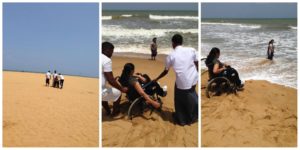 In Mahur, much to the delight of my mother, I was able to take darshan of our family goddess whose temple is situated on top of a hill and the only approach is 120 steps. Thanks to the professional doli’s who carry devotees with mobility difficulties up to the temple.
In Mahur, much to the delight of my mother, I was able to take darshan of our family goddess whose temple is situated on top of a hill and the only approach is 120 steps. Thanks to the professional doli’s who carry devotees with mobility difficulties up to the temple.
In Ahmedabad, I was able to relive my childhood by sitting in the toy train at Kankaria Lake. They had one carriage with a folding ramp that could accommodate a wheelchair.
In Pune, I chanced upon the possibility that even a quadriplegic can do scuba diving. I found out about this over a casual conversation with Divyanshu Ganatra with whom I got in touch only because I was traveling to the city. So what if I practiced in the swimming pool instead of an open sea.
As many of you must have experienced, most places in India are inaccessible. But you can still make the most of it by door darshan 😉
Charminar in Hyderabad is located in the middle of a crowded junction in the old city. The best way to get a closer look was to drive around it. Ditto with the longest beach in India, the Marina beach in Chennai.
Chandni Chowk in old Delhi is also not a friendly destination for wheelchair users. But I did manage to relish the famous Parathas from Parathe Wali Galli in the comfort of my car.
In India, it’s not just the places, even the mode of transport is a barrier. I would have never reached anywhere if I would have waited for an accessible vehicle.
I have enjoyed moving around despite the various physical and mental barriers. Believe it or not, in most situations it is ‘your will’ that can hold you back or let you fly. Forget about being a burden on others or feeling hesitant to demand accessibility or the trouble others will have to go through for taking you to inaccessible places. If it is family and friends, they will go to all lengths joyfully to have your company. If it is movie theaters, restaurants or even the typical tourist destinations, earning your business will only make their pockets smile. I am not so confident about trains and bus services, but airlines do give a preferential treatment to the disabled.
Reality check says that accessibility cannot become a norm and be implemented overnight. That is why do not hold back if your heart aches to venture out. Start with getting out on the street or a park near your home. Be seen. Let the non-disabled people notice that we are also among them and we too like to travel and go places.
Traveling with a disability teaches you to be open to change in plans, be aware that whatever can go wrong could actually go wrong and not get disheartened if external expectations are not met. And more than anything, because of all these experiences you will learn to make the most delicious lemonade of all the lemons life throws your way. Yummy!!!
Give me a shout out and let’s say Cheers the next time you make one.
Happy travels!
Mrunmaiy Abroal is a communications professional and a technology and travel enthusiast. Living with spinal cord injury since 2011, she has not let disability curb her enthusiasm for embarking on new voyages. She believes that things may seem impossible in the beginning, but one has to just keep trying. She also blogs at https://mrunmaiy.com .
Miss Wheechair India 2015 experience and my dream destination Paris – by Sneha Khaitan
/2 Comments/in Personal /by Neha AroraI want to share my travel story about my Bangalore trip. The purpose of going to Bangalore was to participate in a beauty pageant “Miss Wheelchair India 2015” which was held there and I was one of the finalist of that event.
When I got selected and I came to know that I will have to go to Bangalore, I was more nervous about my travel than the event itself. I am suffering from “Muscular Dystrophy” Which lacks body balance and my travel was completely depended on others. The thought of travelling miles away scared the hell out me.
I had never travelled that much distance in my life so far. I live in a very small village of Bihar (Pirpainti, Bhagalpur) and it’s really tough to go to anywhere from here. The major problem is train and there is no airport here within 500 kms.
To catch my flight for Bangalore I had to go to Kolkata airport and from Bhagalpur to Kolkata, I had to travel by train. I felt that trains are pain in India. My Wheelchair could not go through narrow compartments. And 2 male Assistants held me up and took me to my seat. The worst thing was people staring at me. Anyway the experience was not that bad. Airport was quite disabled friendly and I did not faced much problem there except the narrow space between seats. I had faced a little bit trouble while transferring from wheelchair to my seat due to narrow space.
Once I reached Bangalore I did not face much trouble. The whole city was quite accessible including my hotel. I enjoyed a lot. And this is one of the best experiences of my life. I felt fresh and alive. I would love to travel to Bangalore again and many more places of India and abroad. My dream place is Paris and I surely want to travel there at least once in my life.
Even though my journey was not so smooth but it gave me a lot of happiness and a life time experience. Now I would say no one should let their disability and fear come in between their travelling dreams. Keep travelling & keep exploring.
Sneha Khaitan is a Graphic Designer by profession. She is a also a dreamer and believes that one can fulfill all their dreams with their determination.
Subscribe to Our Newsletter

